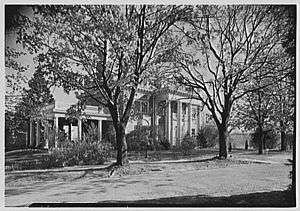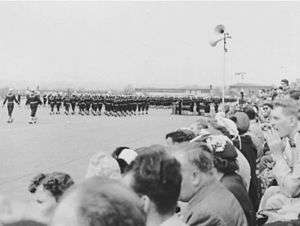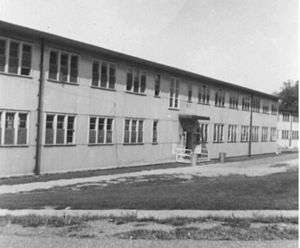United States Naval Training Center, Bainbridge

United States Naval Training Center, Bainbridge (USNTC Bainbridge) was the U.S. Navy Training Center at Port Deposit, Maryland, on the bluffs of the northeast bank of the Susquehanna River. It was active from 1942 to 1976 under the Commander of the Fifth Naval District, based in Norfolk, Virginia.
Located on the appropriated campus of the Tome School for boys, the training center sat between various important naval centers of World War II: about 35 miles (56 km) northeast of Baltimore, Maryland, and 75 miles (121 km) from Washington, D.C., and Philadelphia, Pennsylvania. It was reached via Maryland Route 222, about halfway between US 1 and US 40.
History
Origin
President Franklin Delano Roosevelt personally approved the site, which was seized from the Tome School by Congressional order. Roosevelt also chose the name to honor Commodore William Bainbridge, who commanded the frigate Constitution when it defeated the British frigate HMS Java during the War of 1812.
The campus was expanded by government purchase from 330 acres (1.3 km2) to 1,132 acres (4.58 km2). More than five hundred new buildings were built, some designed by Eggers & Higgins.
World War II
Recruit training
The center was activated on October 1, 1942, and the first batch of recruits arrived 10 days later to begin “boot camp” training. They came in busloads from transportation collection points at Havre de Grace and Perryville, Maryland. The recruits were given a battery of tests to determine their educational and skill levels, then trained in ordnance and gunnery, seamanship, fire fighting, physical training, and military drill.
Halfway through boot camp, recruits had a "service week", which generally included kitchen duty, peeling potatoes, mopping, picking up cigarette butts, etc. Recruits with desirable skills, such as typing, could end up on an office typewriter rather than in a kitchen.
One winter, recruits were used to do snow removal to open up access to a largely rural area in Colora and Rising Sun areas.
Recruits were also trained in shipboard duties aboard the R.T.S. Commodore, a relatively large "ship" built on dry land. The trainer was equipped with most of the facilities found on a real ship, including deck guns, pilot house, davits with whaleboats, and mooring lines fastened to earth-bound bollards, so that crew members could learn casting off hawsers and other lines connecting the ship to its dock.
By the end of World War II, the center had trained 244,277 recruits who transferred to various ships and stations throughout the world.
Non-recruit training
A total of 24,484 recruit graduates were trained and graduated during World War II with technical skills under the direction of the Service School Command.[1]
The following activities, under the control of the Service School Command and the Administrative Command, were located in the Naval Training Center during World War II and were not part of the Recruit Training Command portion of the Naval Training Center:
- Coast Guard School
- Rockefeller Research Unit (Report to Naval Training Station).
- Stewards Mates' School Roll
- Naval Academy Preparatory School
- Naval Hospital
- Hospital Corps School
- Naval Training School (Radio)
- Naval Training School (Fire Controlmen)
- Fire Fighters School
- Naval Training School (Electrical)
- Naval Training School (Physical Instructors)
- Naval Training School (Instructors)
- Naval Training School (Sound Motion Picture Technician)
- Fire Fighters Training Unit)
- Naval Training School (Motion Picture Operators)
- Naval Training School (Recruit Instructors - C)
First deactivation (1947)
The center continued limited operations until June 30, 1947, when it was first inactivated as a Navy training center. The sole remaining activity on campus was the Naval Academy Prep School, and a maintenance staff remained to protect the buildings from weather and other damage.
Reactivation (1951)
In mid-1950, with the advent of the Korean War crisis, plans were made to reactivate the center, and it was officially reopened on February 1, 1951, when Captain Robert Hall Smith took overall command.
The buildings, despite the care of the maintenance staff, were in severe disrepair. A defense contract was awarded to Consolidated Engineering Company of Baltimore, Maryland. The necessary renovations and road work were accomplished ahead of schedule, and the center reopened its gates for recruits on April 5, 1951.
Initially, the center admitted 500 recruits per week, but the rate soon doubled. The first 500 recruits who graduated as seamen recruits on June 23, 1951.
In 1962, a Naval Nuclear Power School was installed on the center, but was eventually moved to Naval Training Center Orlando, Florida]].
Starting in 1943, the Naval Academy Preparatory School (NAPS) was based at Bainbridge. NAPS moved to Newport, Rhode Island, in August 1974.
Second deactivation (1976)
The Center was deactivated in 1976, after which some of its facilities were used by the Department of Labor as a Job Corps Training Center until 1990.
Base closing (1986)
On November 3, 1986, the United States Congress authorized the Secretary of the Navy to dispose of the NTCB (Naval Training Center, Bainbridge) facility by sale to private parties or transfer to other government agencies. NTCB is the Federal Facilities equivalent of a brownfield site with the primary goal of the Navy being effective re-use of the former property by the State of Maryland and the people of Cecil County. Congress specified that before any sale, the Secretary of the Navy was required to “restore such property to a condition that meets all applicable Federal and State of Maryland environmental protection regulations" (Public Law 99-956). The U.S. Navy has transferred this site to the Bainbridge Development Corporation. The cleanup is complete.[2]
Organization
The center was divided into four subordinate activities, each with its own commanding officer:
Administrative Command
The Administrative Command was responsible for the various tasks and services necessary in running a center containing about 35,000 inhabitants. Tasks included base maintenance, physical security, fire protection, logistics, material procurement, medical care, religious services, transportation, and so on.


Recruit Training Command
The Recruit Training Command was the largest of the center’s commands and was responsible for the basic training of recruits. It consisted of four independent commands – known as camps—each of which had its own regimental drill hall, mess hall, barracks, class rooms, and so on:
- Camp Rodgers
- Camp Perry
- Camp James
- Camp Barney
Each camp contained 5,000 male recruits. A training school was established for WAVE recruits in October 1951. Circa 1959, male recruit training at Bainbridge was closed and male recruit training was only in Great Lakes, Illinois and San Diego, California. Bainbridge was the sole recruit training center for Waves until moving to Orlando, Florida in 1972.
Service School Command
The Service School Command was organized to train selected personnel who had completed “recruit” basic training and demonstrated an aptitude for a skill during initial recruit testing. The command had a capacity of providing specialty training to 4,000 sailors at a time. These personnel were assigned to training in gunnery, fire control, radio, telemetry, and other technical subjects.
The Naval Academy Preparatory School was a component of the Service School Command and was chartered to train enlisted personnel for acceptance into the U.S. Naval Academy at Annapolis, Maryland. The school also trained sailors and marines in necessary academic skills required for admission to colleges and universities under the Naval Reserve Officers Training Corps.
Naval Hospital
The naval hospital was established as a 500-bed hospital for the care of center operating staff, recruits, students and dependents, with provision to increase capacity to 1,000-beds or more if necessary.
The Hospital Corps School, with approximately 1,200 students studying to become Hospital Corpsmen, operated in conjunction with the naval hospital.
Famous people who served at the USNTC
- Charlie "Choo Choo" Justice University of North Carolina at Chapel Hill football star & two-time Heisman Trophy runner-up
- Admiral Frank B. Kelso II (1933-), who later became Chief of Naval Operations, commanded the U.S. Naval Nuclear Power School at the U.S. Naval Training Center Bainbridge from 1969-71.
- Paul Pierce, who later became head football coach at Sul Ross State University and Sam Houston State University.
- Bill Cosby Actor and comedian[3]
See also
References
- The Compass, United States Naval Training Center, Bainbridge, Maryland. Atlanta, Georgia: Albert Love. 1954.
External links
Coordinates: 39°36′45″N 76°05′30″W / 39.61250°N 76.09167°W